Business Decision Making: Evaluating NPV, Payback, and Key Factors
VerifiedAdded on 2023/01/13
|7
|1442
|3
Report
AI Summary
This report provides an analysis of business decision-making, focusing on the application of Net Present Value (NPV) and payback period methods. It includes calculations for both Project A and Project B, demonstrating how to determine the payback period and NPV for each. The analysis highlights the advantages and disadvantages of using NPV and payback period in decision-making, emphasizing that NPV offers a more accurate reflection of results due to the use of discounting factors, while the payback period provides a simpler assessment of viability based on the recovery of initial costs. Furthermore, the report discusses the importance of considering both financial and non-financial factors, such as interest rates, economic growth, and SWOT/PESTLE analyses, to enhance the effectiveness of financial and business decisions. It concludes that while NPV is generally preferable for evaluating project profitability, a comprehensive approach that incorporates various financial and non-financial elements is crucial for making well-informed decisions. Desklib offers a range of study tools, including solved assignments and past papers, to support students in mastering these concepts.

Business Decision
Making
Making
Paraphrase This Document
Need a fresh take? Get an instant paraphrase of this document with our AI Paraphraser
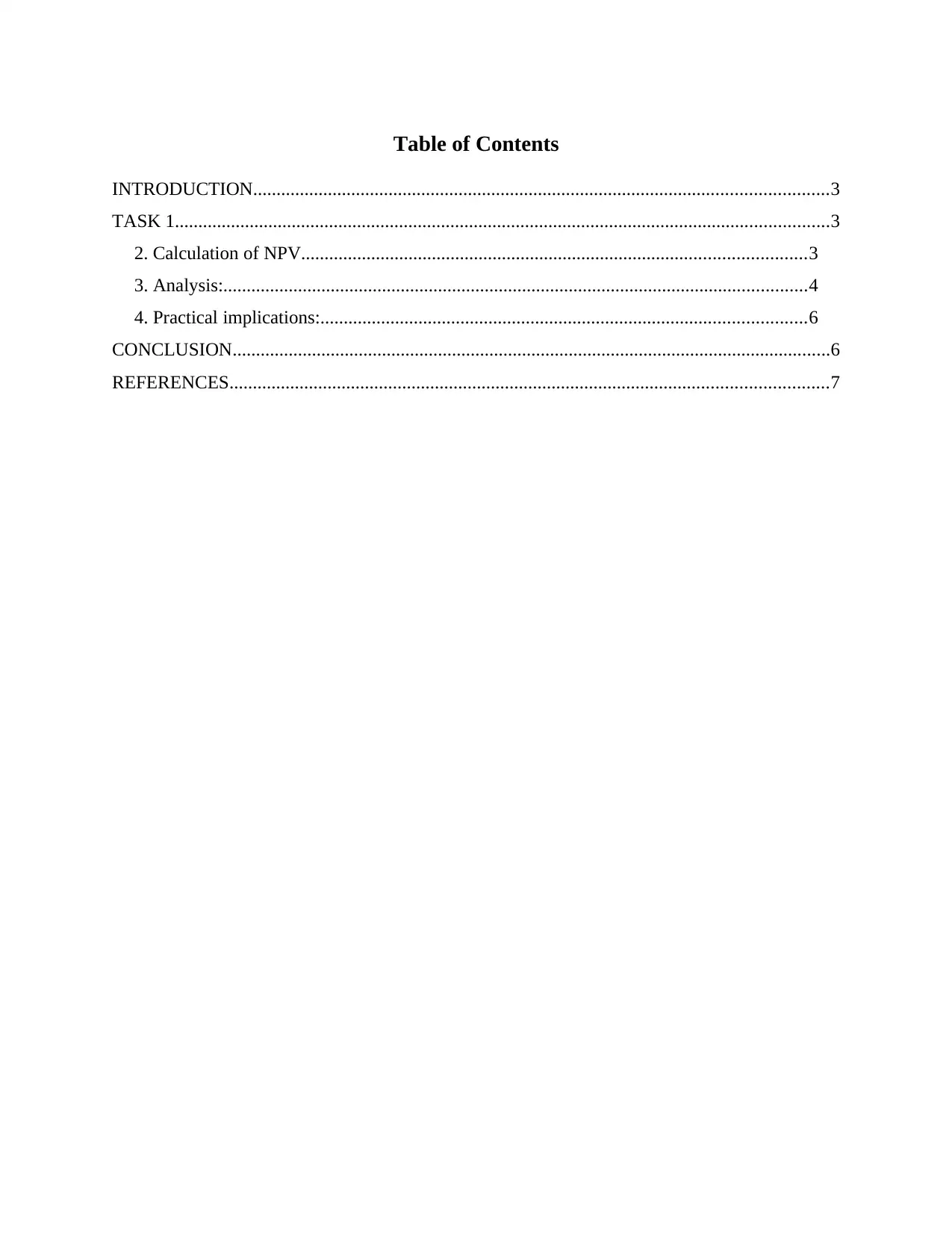
Table of Contents
INTRODUCTION...........................................................................................................................3
TASK 1............................................................................................................................................3
2. Calculation of NPV............................................................................................................3
3. Analysis:.............................................................................................................................4
4. Practical implications:........................................................................................................6
CONCLUSION................................................................................................................................6
REFERENCES................................................................................................................................7
INTRODUCTION...........................................................................................................................3
TASK 1............................................................................................................................................3
2. Calculation of NPV............................................................................................................3
3. Analysis:.............................................................................................................................4
4. Practical implications:........................................................................................................6
CONCLUSION................................................................................................................................6
REFERENCES................................................................................................................................7

INTRODUCTION
Business Decision-making is an intrinsic aspect of modern managerial and governance
within business. Basically, the main role of management is taking fair or sensible decision-
making. It involves all critical steps involved in taking business related decisions. Decisions
taken by managers should bear a value for business also according to the business needs and
requirements (Zeng, Chen and Li, 2016). This study assessment covers multiple aspects of
business decision-making and terms and factors which are used in relation to it like NPV,
payback time as well as financial/non-financial variables.
TASK 1
1. Calculation of the payback period
For Project A
Calculation of payback period of project A
Year Net Flow Total
1 8000 (40000)
2 12000 (32000)
3 16000 (20000)
4 20000 (4000)
5 30000
Payback period = 3 years and 2.4 months.
For Project B
Year Net Flow Total
1 10000 (60000)
2 20000 (50000)
3 25000 (30000)
4 30000 ( 5000)
5 40000
The Payback Period is: 3 years and 2. months.
2. Calculation of NPV
Year Net Cash Flow £ Discount Factor At 12% Present Value
1 8000 .893 7144
Business Decision-making is an intrinsic aspect of modern managerial and governance
within business. Basically, the main role of management is taking fair or sensible decision-
making. It involves all critical steps involved in taking business related decisions. Decisions
taken by managers should bear a value for business also according to the business needs and
requirements (Zeng, Chen and Li, 2016). This study assessment covers multiple aspects of
business decision-making and terms and factors which are used in relation to it like NPV,
payback time as well as financial/non-financial variables.
TASK 1
1. Calculation of the payback period
For Project A
Calculation of payback period of project A
Year Net Flow Total
1 8000 (40000)
2 12000 (32000)
3 16000 (20000)
4 20000 (4000)
5 30000
Payback period = 3 years and 2.4 months.
For Project B
Year Net Flow Total
1 10000 (60000)
2 20000 (50000)
3 25000 (30000)
4 30000 ( 5000)
5 40000
The Payback Period is: 3 years and 2. months.
2. Calculation of NPV
Year Net Cash Flow £ Discount Factor At 12% Present Value
1 8000 .893 7144
⊘ This is a preview!⊘
Do you want full access?
Subscribe today to unlock all pages.

Trusted by 1+ million students worldwide
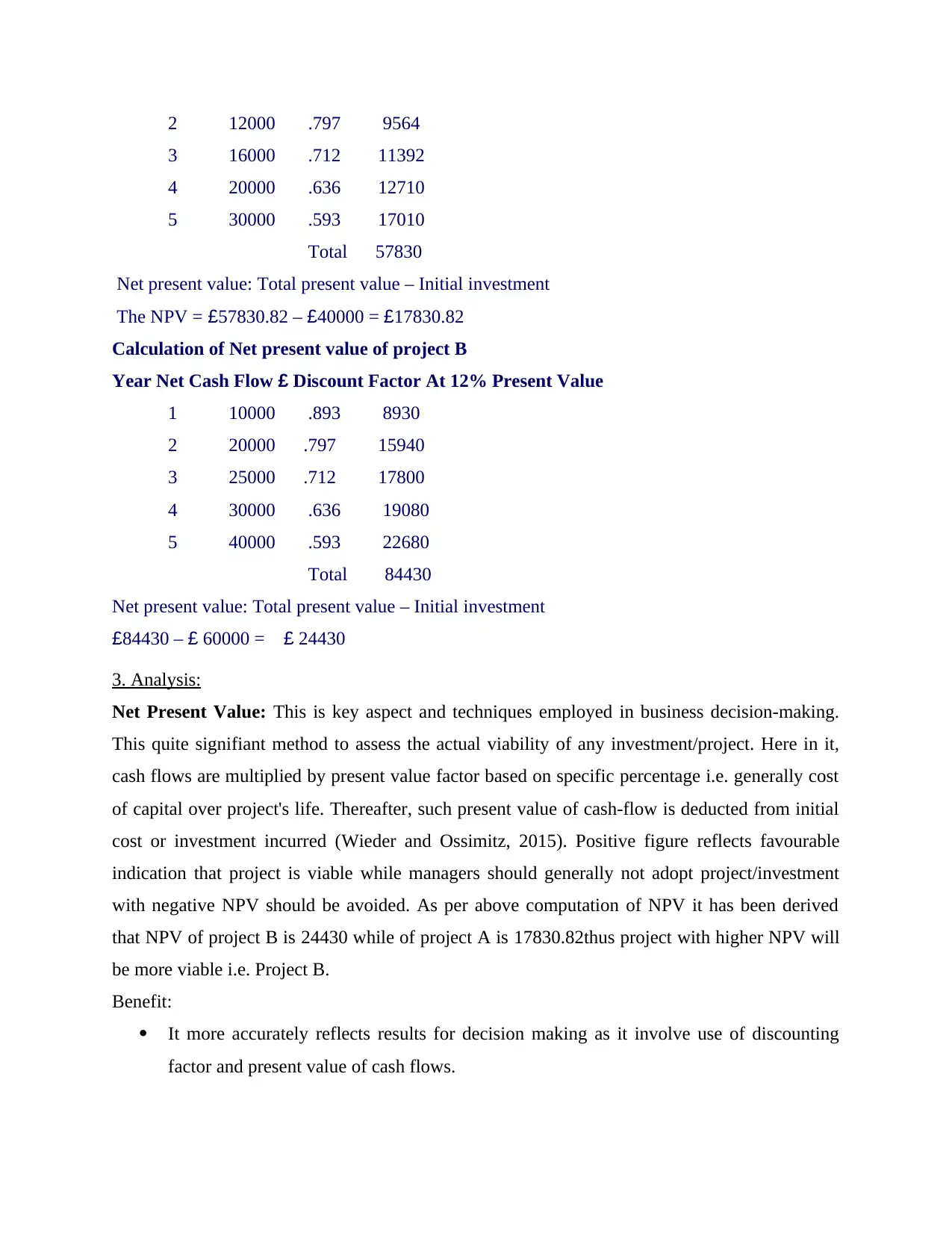
2 12000 .797 9564
3 16000 .712 11392
4 20000 .636 12710
5 30000 .593 17010
Total 57830
Net present value: Total present value – Initial investment
The NPV = £57830.82 – £40000 = £17830.82
Calculation of Net present value of project B
Year Net Cash Flow £ Discount Factor At 12% Present Value
1 10000 .893 8930
2 20000 .797 15940
3 25000 .712 17800
4 30000 .636 19080
5 40000 .593 22680
Total 84430
Net present value: Total present value – Initial investment
£84430 – £ 60000 = £ 24430
3. Analysis:
Net Present Value: This is key aspect and techniques employed in business decision-making.
This quite signifiant method to assess the actual viability of any investment/project. Here in it,
cash flows are multiplied by present value factor based on specific percentage i.e. generally cost
of capital over project's life. Thereafter, such present value of cash-flow is deducted from initial
cost or investment incurred (Wieder and Ossimitz, 2015). Positive figure reflects favourable
indication that project is viable while managers should generally not adopt project/investment
with negative NPV should be avoided. As per above computation of NPV it has been derived
that NPV of project B is 24430 while of project A is 17830.82thus project with higher NPV will
be more viable i.e. Project B.
Benefit:
It more accurately reflects results for decision making as it involve use of discounting
factor and present value of cash flows.
3 16000 .712 11392
4 20000 .636 12710
5 30000 .593 17010
Total 57830
Net present value: Total present value – Initial investment
The NPV = £57830.82 – £40000 = £17830.82
Calculation of Net present value of project B
Year Net Cash Flow £ Discount Factor At 12% Present Value
1 10000 .893 8930
2 20000 .797 15940
3 25000 .712 17800
4 30000 .636 19080
5 40000 .593 22680
Total 84430
Net present value: Total present value – Initial investment
£84430 – £ 60000 = £ 24430
3. Analysis:
Net Present Value: This is key aspect and techniques employed in business decision-making.
This quite signifiant method to assess the actual viability of any investment/project. Here in it,
cash flows are multiplied by present value factor based on specific percentage i.e. generally cost
of capital over project's life. Thereafter, such present value of cash-flow is deducted from initial
cost or investment incurred (Wieder and Ossimitz, 2015). Positive figure reflects favourable
indication that project is viable while managers should generally not adopt project/investment
with negative NPV should be avoided. As per above computation of NPV it has been derived
that NPV of project B is 24430 while of project A is 17830.82thus project with higher NPV will
be more viable i.e. Project B.
Benefit:
It more accurately reflects results for decision making as it involve use of discounting
factor and present value of cash flows.
Paraphrase This Document
Need a fresh take? Get an instant paraphrase of this document with our AI Paraphraser
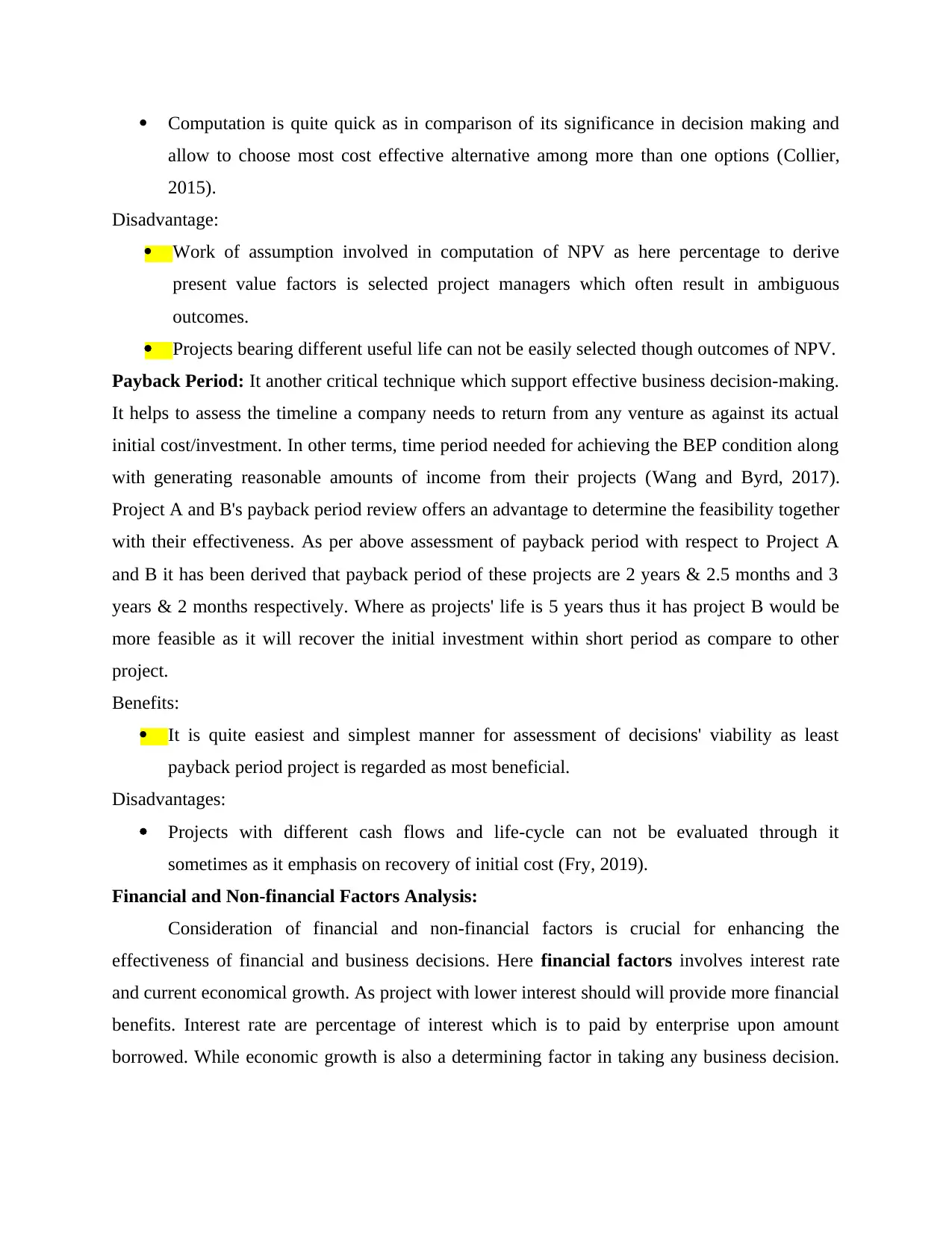
Computation is quite quick as in comparison of its significance in decision making and
allow to choose most cost effective alternative among more than one options (Collier,
2015).
Disadvantage:
Work of assumption involved in computation of NPV as here percentage to derive
present value factors is selected project managers which often result in ambiguous
outcomes.
Projects bearing different useful life can not be easily selected though outcomes of NPV.
Payback Period: It another critical technique which support effective business decision-making.
It helps to assess the timeline a company needs to return from any venture as against its actual
initial cost/investment. In other terms, time period needed for achieving the BEP condition along
with generating reasonable amounts of income from their projects (Wang and Byrd, 2017).
Project A and B's payback period review offers an advantage to determine the feasibility together
with their effectiveness. As per above assessment of payback period with respect to Project A
and B it has been derived that payback period of these projects are 2 years & 2.5 months and 3
years & 2 months respectively. Where as projects' life is 5 years thus it has project B would be
more feasible as it will recover the initial investment within short period as compare to other
project.
Benefits:
It is quite easiest and simplest manner for assessment of decisions' viability as least
payback period project is regarded as most beneficial.
Disadvantages:
Projects with different cash flows and life-cycle can not be evaluated through it
sometimes as it emphasis on recovery of initial cost (Fry, 2019).
Financial and Non-financial Factors Analysis:
Consideration of financial and non-financial factors is crucial for enhancing the
effectiveness of financial and business decisions. Here financial factors involves interest rate
and current economical growth. As project with lower interest should will provide more financial
benefits. Interest rate are percentage of interest which is to paid by enterprise upon amount
borrowed. While economic growth is also a determining factor in taking any business decision.
allow to choose most cost effective alternative among more than one options (Collier,
2015).
Disadvantage:
Work of assumption involved in computation of NPV as here percentage to derive
present value factors is selected project managers which often result in ambiguous
outcomes.
Projects bearing different useful life can not be easily selected though outcomes of NPV.
Payback Period: It another critical technique which support effective business decision-making.
It helps to assess the timeline a company needs to return from any venture as against its actual
initial cost/investment. In other terms, time period needed for achieving the BEP condition along
with generating reasonable amounts of income from their projects (Wang and Byrd, 2017).
Project A and B's payback period review offers an advantage to determine the feasibility together
with their effectiveness. As per above assessment of payback period with respect to Project A
and B it has been derived that payback period of these projects are 2 years & 2.5 months and 3
years & 2 months respectively. Where as projects' life is 5 years thus it has project B would be
more feasible as it will recover the initial investment within short period as compare to other
project.
Benefits:
It is quite easiest and simplest manner for assessment of decisions' viability as least
payback period project is regarded as most beneficial.
Disadvantages:
Projects with different cash flows and life-cycle can not be evaluated through it
sometimes as it emphasis on recovery of initial cost (Fry, 2019).
Financial and Non-financial Factors Analysis:
Consideration of financial and non-financial factors is crucial for enhancing the
effectiveness of financial and business decisions. Here financial factors involves interest rate
and current economical growth. As project with lower interest should will provide more financial
benefits. Interest rate are percentage of interest which is to paid by enterprise upon amount
borrowed. While economic growth is also a determining factor in taking any business decision.
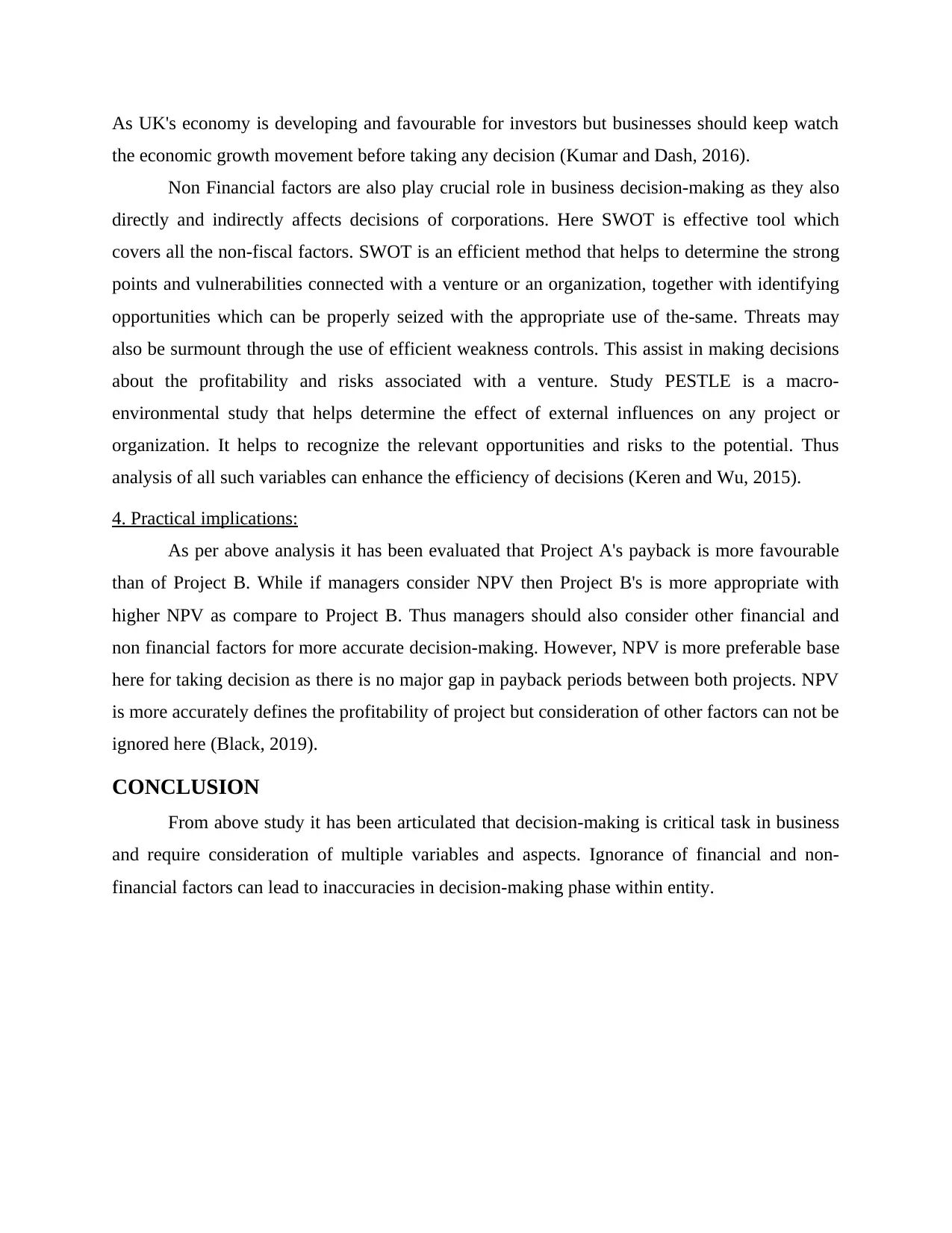
As UK's economy is developing and favourable for investors but businesses should keep watch
the economic growth movement before taking any decision (Kumar and Dash, 2016).
Non Financial factors are also play crucial role in business decision-making as they also
directly and indirectly affects decisions of corporations. Here SWOT is effective tool which
covers all the non-fiscal factors. SWOT is an efficient method that helps to determine the strong
points and vulnerabilities connected with a venture or an organization, together with identifying
opportunities which can be properly seized with the appropriate use of the-same. Threats may
also be surmount through the use of efficient weakness controls. This assist in making decisions
about the profitability and risks associated with a venture. Study PESTLE is a macro-
environmental study that helps determine the effect of external influences on any project or
organization. It helps to recognize the relevant opportunities and risks to the potential. Thus
analysis of all such variables can enhance the efficiency of decisions (Keren and Wu, 2015).
4. Practical implications:
As per above analysis it has been evaluated that Project A's payback is more favourable
than of Project B. While if managers consider NPV then Project B's is more appropriate with
higher NPV as compare to Project B. Thus managers should also consider other financial and
non financial factors for more accurate decision-making. However, NPV is more preferable base
here for taking decision as there is no major gap in payback periods between both projects. NPV
is more accurately defines the profitability of project but consideration of other factors can not be
ignored here (Black, 2019).
CONCLUSION
From above study it has been articulated that decision-making is critical task in business
and require consideration of multiple variables and aspects. Ignorance of financial and non-
financial factors can lead to inaccuracies in decision-making phase within entity.
the economic growth movement before taking any decision (Kumar and Dash, 2016).
Non Financial factors are also play crucial role in business decision-making as they also
directly and indirectly affects decisions of corporations. Here SWOT is effective tool which
covers all the non-fiscal factors. SWOT is an efficient method that helps to determine the strong
points and vulnerabilities connected with a venture or an organization, together with identifying
opportunities which can be properly seized with the appropriate use of the-same. Threats may
also be surmount through the use of efficient weakness controls. This assist in making decisions
about the profitability and risks associated with a venture. Study PESTLE is a macro-
environmental study that helps determine the effect of external influences on any project or
organization. It helps to recognize the relevant opportunities and risks to the potential. Thus
analysis of all such variables can enhance the efficiency of decisions (Keren and Wu, 2015).
4. Practical implications:
As per above analysis it has been evaluated that Project A's payback is more favourable
than of Project B. While if managers consider NPV then Project B's is more appropriate with
higher NPV as compare to Project B. Thus managers should also consider other financial and
non financial factors for more accurate decision-making. However, NPV is more preferable base
here for taking decision as there is no major gap in payback periods between both projects. NPV
is more accurately defines the profitability of project but consideration of other factors can not be
ignored here (Black, 2019).
CONCLUSION
From above study it has been articulated that decision-making is critical task in business
and require consideration of multiple variables and aspects. Ignorance of financial and non-
financial factors can lead to inaccuracies in decision-making phase within entity.
⊘ This is a preview!⊘
Do you want full access?
Subscribe today to unlock all pages.

Trusted by 1+ million students worldwide
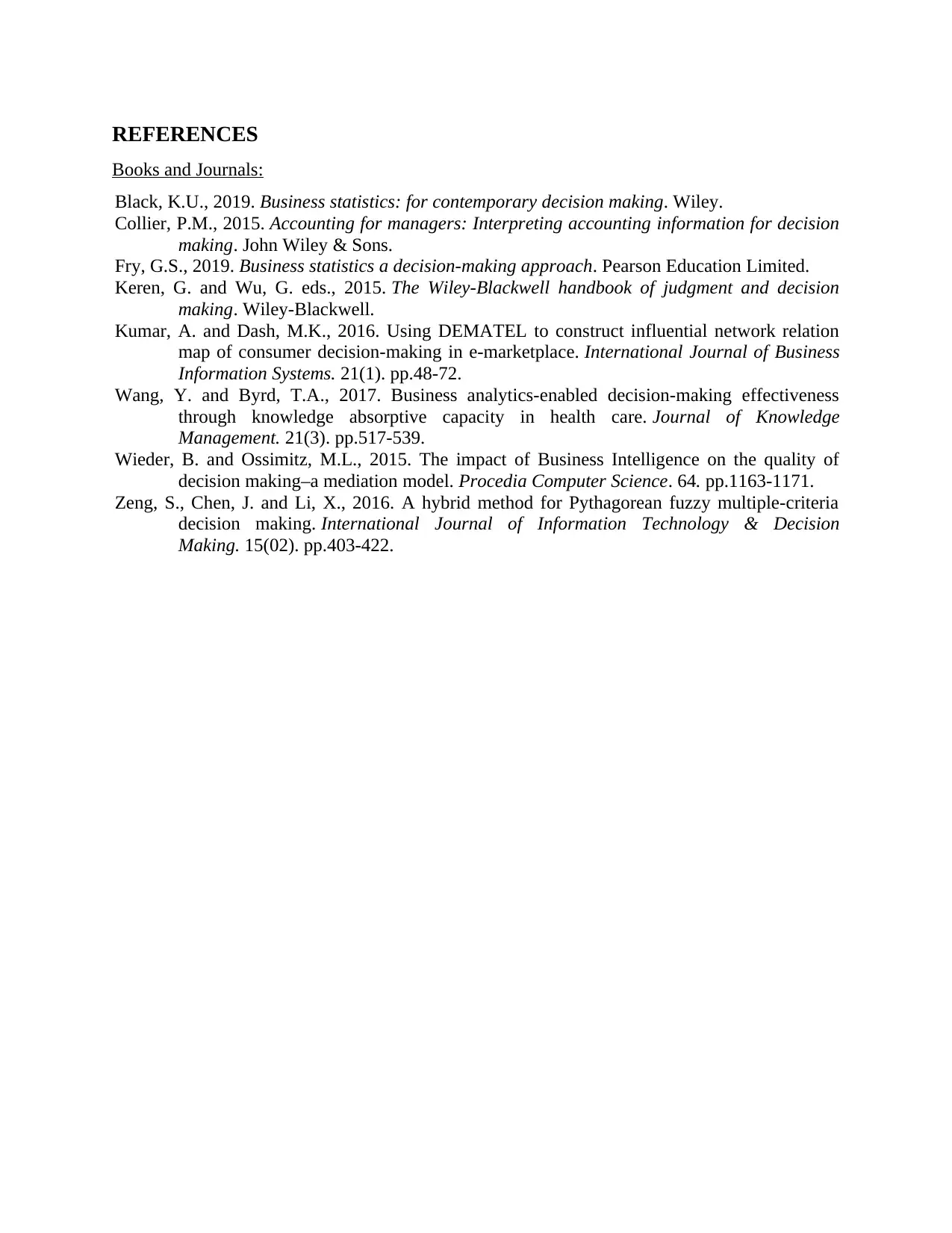
REFERENCES
Books and Journals:
Black, K.U., 2019. Business statistics: for contemporary decision making. Wiley.
Collier, P.M., 2015. Accounting for managers: Interpreting accounting information for decision
making. John Wiley & Sons.
Fry, G.S., 2019. Business statistics a decision-making approach. Pearson Education Limited.
Keren, G. and Wu, G. eds., 2015. The Wiley-Blackwell handbook of judgment and decision
making. Wiley-Blackwell.
Kumar, A. and Dash, M.K., 2016. Using DEMATEL to construct influential network relation
map of consumer decision-making in e-marketplace. International Journal of Business
Information Systems. 21(1). pp.48-72.
Wang, Y. and Byrd, T.A., 2017. Business analytics-enabled decision-making effectiveness
through knowledge absorptive capacity in health care. Journal of Knowledge
Management. 21(3). pp.517-539.
Wieder, B. and Ossimitz, M.L., 2015. The impact of Business Intelligence on the quality of
decision making–a mediation model. Procedia Computer Science. 64. pp.1163-1171.
Zeng, S., Chen, J. and Li, X., 2016. A hybrid method for Pythagorean fuzzy multiple-criteria
decision making. International Journal of Information Technology & Decision
Making. 15(02). pp.403-422.
Books and Journals:
Black, K.U., 2019. Business statistics: for contemporary decision making. Wiley.
Collier, P.M., 2015. Accounting for managers: Interpreting accounting information for decision
making. John Wiley & Sons.
Fry, G.S., 2019. Business statistics a decision-making approach. Pearson Education Limited.
Keren, G. and Wu, G. eds., 2015. The Wiley-Blackwell handbook of judgment and decision
making. Wiley-Blackwell.
Kumar, A. and Dash, M.K., 2016. Using DEMATEL to construct influential network relation
map of consumer decision-making in e-marketplace. International Journal of Business
Information Systems. 21(1). pp.48-72.
Wang, Y. and Byrd, T.A., 2017. Business analytics-enabled decision-making effectiveness
through knowledge absorptive capacity in health care. Journal of Knowledge
Management. 21(3). pp.517-539.
Wieder, B. and Ossimitz, M.L., 2015. The impact of Business Intelligence on the quality of
decision making–a mediation model. Procedia Computer Science. 64. pp.1163-1171.
Zeng, S., Chen, J. and Li, X., 2016. A hybrid method for Pythagorean fuzzy multiple-criteria
decision making. International Journal of Information Technology & Decision
Making. 15(02). pp.403-422.
1 out of 7
Related Documents
Your All-in-One AI-Powered Toolkit for Academic Success.
+13062052269
info@desklib.com
Available 24*7 on WhatsApp / Email
![[object Object]](/_next/static/media/star-bottom.7253800d.svg)
Unlock your academic potential
Copyright © 2020–2025 A2Z Services. All Rights Reserved. Developed and managed by ZUCOL.





